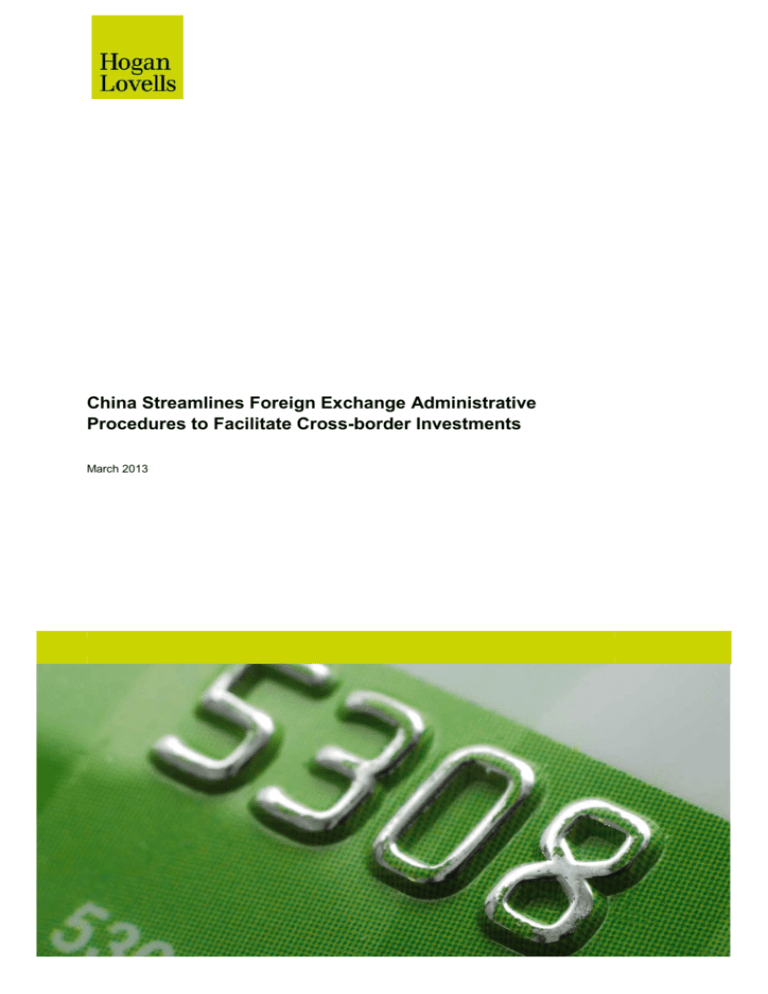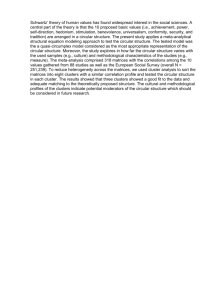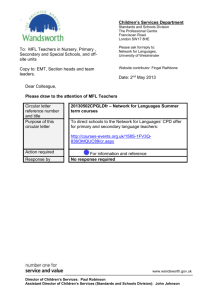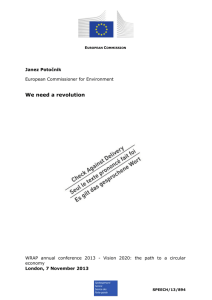
China Streamlines Foreign Exchange Administrative
Procedures to Facilitate Cross-border Investments
March 2013
Further information
If you would like further information on any aspect of the alert
please contact a person mentioned below or the person with
whom you usually deal.
Contacts
Beijing
Jun Wei
T +86 10 6582 9501
jun.wei@hoganlovells.com
Steven Robinson
T +86 10 6582 9568
steven.robinson@hoganlovells.com
Roy Zou
T +86 10 6582 9596
roy.zou@hoganlovells.com
Liang Xu
T +86 10 6582 9577
liang.xu@hoganlovells.com
Shanghai
Andrew McGinty
T +86 21 6122 3866
andrew.mcginty@hoganlovells.com
Philip Cheng
T +86 21 6122 3816
philip.cheng@hoganlovells.com
Michael Chin
T +86 21 6122 3808
michael.chin@hoganlovells.com
Our unofficial in-house translation of Circular 59 is available on
request.
This note is written as a general guide only. It should not be
relied upon as a substitute for specific legal advice.
Contents
SUMMARY OF KEY CHANGES
2
ASSET REALIZATION ACCOUNTS (资产变现账户 "ARAS")
3
FOREIGN EXCHANGE ACCOUNTS FOR UPFRONT EXPENSES ("EXPENSE ACCOUNTS")
5
RE-INVESTMENT IN CHINA
5
OUTBOUND INVESTMENT
7
ROUND-TRIPPING INVESTMENTS
9
CONCLUSION
10
1
China Streamlines Foreign Exchange Administrative Procedures to
Facilitate Cross-border Investments
China's foreign exchange regulator, the State Administration of Foreign Exchange ("SAFE"), recently issued the Circular on
Further Improving and Adjusting Foreign Exchange Administration Policies on Direct Investment (国家外汇管理局关于进一步改
进和调整直接投资外汇管理政策的通知, Hui Fa [2012] No. 59, "Circular 59"). Circular 59, which became effective on 17
December 2012, relaxes controls on cross-border foreign exchange flows in connection with foreign direct investments into
China ("FDI"), as well as facilitating Chinese outbound investment.
To put this development into context, Circular 59 can be seen as a major overhaul of China's foreign exchange regime, which
was established in the 1990s when China was hungry for foreign capital and had very low foreign exchange reserves. Fast
forward through 20 years of rapid economic development, and China has now become the holder of the largest foreign
1
exchange reserves in the world. China is also making determined efforts to 'internationalize' its currency, the Renminbi . It was
perhaps felt time for China, having handed our power to a new generation of leaders, to move away from the strict controls that
were more suited to an earlier era and to focus more on facilitating inbound and outbound commerce and investment in a
difficult international economic environment.
Traditionally, China has divided cross-border payments into two categories, one for 'current account' items which refer to trade
and other recurring transactions, and the other for 'capital account' items which basically cover equity investments and
loans/debts. Under the existing regime, China imposes strict restrictions on capital account transactions, which are subject to
SAFE approval both for the opening of the account, as well as for fund movements within such an account. Current account
items are liberalised and hence SAFE's pre-approval is generally not required; payment can normally be processed directly by a
2
designated foreign exchange bank subject to performing checks to confirm that there is a genuine and lawful underlying
transaction.
Circular 59 reflects SAFE's intention to gradually relax restrictions on capital account transactions, and more broadly the trend
towards the type of lighter touch regulation applicable to current account transactions. For instance, Circular 59 abolishes the
original requirement for SAFE approval under certain circumstances, streamlines the processes by reducing documentary
requirements and shortening timelines, and eases restrictions on the use of capital for direct investment purposes. As will
become clear from the analysis below, SAFE will primarily require the relevant transaction information to be registered with it
rather than approval of the transaction, and commercial banks will play an increasingly important role in the process. It will be
the banks, not SAFE that will review specific documents to ensure that the proposed flow of foreign exchange is necessary and
justified. In addition, they will file details on the cases they handle in the uniform database system (the "SAFE System"), so that
SAFE can oversee and use such information for statistical purposes. All in all, Circular 59 marks yet another important step on
the road towards the long-term goal of liberalisation of conversion out of, or into, the RMB on the capital account, including for
FDI and outbound investment transactions.
This article discusses certain changes brought about to China's foreign exchange control regime by Circular 59, and analyses in
detail how they may facilitate both inbound investment to China and outbound investment from China.
1
See our client note 'New Channel Opened for Flowing-back of Overseas Renminbi'.
2
Most of the large Chinese and international commercial banks in China are designated as foreign exchange banks.
2
I.
Summary of Key Changes
Foreign Exchange
Administration Matter
Before Circular 59
After Circular 59
Opening of Pre-investment
Expense Account, Foreign
Capital Account, Asset
Realization Account, and
Security Account
SAFE approval required, which
may take up to 20 working days
No approval required; can open
account directly at bank
Payment into Asset Realization
Account and Outbound Lending
Special Account
SAFE approval required, which
may take up to 20 working days
No approval required; bank can
deposit funds directly based on
information in SAFE system
Opening of Foreign Exchange
Capital Account and Asset
Realization Account outside the
residence of the FIE in question
Restricted
Restriction removed
Number of Foreign Exchange
Capital Accounts for each FIE
Restricted
Restriction removed
Purchase and remittance of
foreign exchange as a result of
capital reduction, liquidation or
early repatriation of investment in
an FIE
SAFE approval required, which
may take up to 20 working days
No approval required; bank can
directly process based on
information in SAFE system
Purchase and remittance of
foreign exchange as a result of
transfer of equity in FIE to a
Chinese domestic entity or
individual
SAFE approval required, which
may take up to 20 working days
No approval required; bank can
directly process based on
information in SAFE system
Purchase and remittance of
upfront expenses for Chinese
outbound investment
SAFE approval required
No approval required; bank can
directly process based on
information in SAFE system
Remittance of funds from
Outbound Lending Special
Account
SAFE approval required
No approval required; bank can
directly process based on
information in SAFE system
Conversion of registered foreign
debt into equity; re-investment of
capital reserve fund,
undistributed dividend, etc.
SAFE approval required
No approval required; bank can
directly process based on
information in SAFE system
Re-investment of lawful incomes
derived in China, such as profit,
proceeds of equity transfer,
capital reduction, liquidation and
early repatriation of investment
SAFE approval required
No approval required; bank can
directly process based on
information in SAFE system
Payment of capital contribution
SAFE approval required
No approval required; bank can
3
by a foreign Investment
Company (as defined below) in
China; payment of dividend to
such Investment Company
II.
directly process based on
information in SAFE system
SAFE registration of investee
company of a foreign Investment
Company (as defined below) in
China
SAFE registration required
Not required unless there is
another offshore investor in the
investee company
Extension of loan from FIE to its
offshore shareholders
Not permitted
Permitted with restriction on
amount
Asset Realization Accounts (资产变现账户 "ARAs")
Circular 59 provides for two types of ARAs: one for realization of onshore assets (境内资产变现账户 "Onshore Asset ARAs")
and the other for realization of offshore assets (境外资产变现账户"Offshore Asset ARAs"). The opening of, changes to,
cancellation of, or the remittance of foreign exchange funds into, an ARA no longer requires SAFE's pre-approval. Previously
each of these items was subject to such pre-approval. For domestic sellers (whether a company or an individual) selling
onshore or offshore assets to foreign investors, this means that a bank designated by SAFE to handle foreign exchange matters
3
(a "Bank") can, based on the relevant information or form recorded in the SAFE System , directly open, change or cancel an
ARA, and accept remittances of foreign exchange funds into such account (subject to the inflow quota recorded in the SAFE
System in the case of an Offshore Asset ARA).
For any given transaction for the transfer of onshore equity interests, a domestic seller can only open one ARA. SAFE no
longer requires this ARA to be opened in the seller's locality. When the foreign investor remits the consideration from an
offshore account into such ARA, the seller's Bank should, on the strength of the Equity Transfer Information Registration Form
recorded in the SAFE System, accept the remittance and report the arrival of the remittance to the SAFE System, which will
then automatically confirm the capital contribution made by the foreign investor in respect of the target equity interests ("Capital
Contribution Confirmation"). The ARA funds cannot be used until the Capital Contribution Confirmation is issued.
The funds held in an ARA can be used to make payments under current account transactions (subject to the Bank checking to
confirm that the underlying transaction is lawful and genuine) as well as capital account transactions approved by, or registered
with, SAFE. The foreign currency funds can also be converted into RMB. However, if the ARA owner is a company, conversion
should follow the same rules as are applicable to conversion within foreign exchange capital accounts for Foreign Invested
4
Enterprises ("FIEs"). Essentially, this means a corporate ARA owner needs to follow Circular 142 of 2008 for purposes of
conversion: it must present payment instructions and documentary proof confirming use of proceeds (e.g., a purchase contract)
3
Namely, Equity Transfer Information Registration Form in the case of an Onshore Asset ARA, or the foreign exchange registration form of a PRC resident
company or the Foreign Exchange Registration Form relating to Overseas Investments by a PRC Individual Resident (境内居民个人境外投资外汇登记表) in the
case of an Offshore Asset ARA.
4
The Notice issued by SAFE on 29 August 2008 regarding Relevant Issues on Enhancing the Management and Operation of Payments and Conversion of
Foreign Exchange Capital of Foreign Invested Enterprises (国家外汇管理局综合司关于完善外商投资企业外汇资本金支付结汇管理有关业务操作问题
的通知).
4
when applying for conversion into RMB. If the account owner is an individual, however, conversion of foreign exchange into
RMB only requires a tax clearance certificate.
In addition, Circular 59 also allows transfer of the funds in an ARA to the following types of accounts (without conversion into
RMB) based on actual needs and premised on a genuine and lawful underlying transaction: special guarantee accounts for
receiving remittances within China (境内划入保证金专用账户), domestic reinvestment special purpose accounts (境内再投资专
用账户), entrusted loan accounts (委托贷款账户), cash pooling accounts (资金集中管理专户), outbound lending special purpose
accounts (境外放款专用账户), and principal-protected money management special accounts (保本型银行理财专户).
Compared with the previous rules regarding SAFE's control over asset realization accounts, Circular 59 has materially eased
restrictions on the use of ARAs and delegated more power to Banks. Furthermore, it substantially streamlines the
documentation required to be submitted to Banks or filed with SAFE, such that Banks will rely on the SAFE System more than
ever. The SAFE System will save applicants time and avoid re-submission of the same documents for different pre-approvals at
different stages. For example, under the previous rules, the opening of, change to, cancellation of, and remittance of funds into,
a foreign exchange account were all subject to SAFE pre-approval. Each of these items could take up to 20 working days under
the relevant rules. If the consideration for the target assets were paid in multiple instalments, the remittance of each instalment
into the account would require a separate SAFE pre-approval, which would obviously prolong and delay the whole transaction
completion process. Circular 59 repeal the requirement for SAFE pre-approval for each of these items.
Circular 59 also makes it easier for individual Chinese sellers to convert foreign exchange funds in an ARA. Prior to the
promulgation of the SAFE Circular on Issues relevant to Further Clarification and Standardization of the Administration of
Certain Foreign Exchange Matters regarding Capital Accounts (国家外汇管理局关于进一步明确和规范部分资本项目外汇业务管
理有关问题的通知, Hui Fa [2011] No. 45, "Circular 45") on 9 November 2011, conversion of foreign exchange (whether owned
by a domestic individual or a domestic capital company) was subject to the same rules as are applicable to conversion of
foreign exchange in capital accounts of FIEs. The previous rules did not differentiate between company account owners and
5
individual account owners, which made the conversion of funds in an ARA owned by an individual equally difficult.
Following Circular 142 of 2008, an individual seller would also be required to submit documentary proof confirming use of
proceeds (e.g., a purchase contract) and justify each disbursement by official tax receipts issued by the goods or services
vendor (Fapiao) in connection with its application to convert foreign exchange into RMB. As a result, if an individual seller did
not have a specific plan on how to spend the converted RMB, he would not be allowed to convert his sales proceeds into RMB.
Under Circular 45 and as confirmed by Circular 59, as long as the individual owner of an ARA has obtained the required foreign
exchange registration form and a tax clearance certificate for the equity transfer, he or she may apply to the Bank for conversion
of foreign exchange received in the ARA without having a specific plan on how to spend the RMB funds derived from the
conversion. Under Circular 59, upon the Capital Contribution Confirmation and obtaining of the tax clearance certificate by the
individual owner of an ARA, such owner may apply to the Bank for conversion of foreign exchange in the ARA without
5
ARSFEA refers to Asset Realization Special Foreign Exchange Account (资产变现专用外汇账户), which was used under previous rules. This is
basically the same as ARA.
5
submitting any Fapiao. In other words, Circular 59 and related rules make it easier for individual sellers to convert sales
proceeds and keep RMB as long as they have paid the requisite taxes.
III.
Foreign Exchange Accounts for Upfront Expenses ("Expense Accounts")
Foreign investors are allowed to open an Expense Account (前期费用外汇账户) in China to cover upfront costs before they set
up an FIE. According to Circular 59, an Expense Account is used to deposit a foreign investor's money to fund all types of
upfront expenses in relation to direct investment activities in China. Under Circular 59, as long as a foreign investor files a
Foreign Direct Investment Foreign Exchange Registration Form (外商直接投资外汇登记业务申请表) with SAFE, together with
the FIE name reservation approval, and is granted a quota on the inflow of upfront expenses (in foreign currency) by SAFE, the
following items will no longer require any SAFE pre-approval: the opening of, changes to and cancellation of an Expense
Account, and payments into such account.
Compared with the previous rules, Circular 59 also relaxes SAFE controls on the use of foreign exchange funds in an Expense
Account from the following two angles: (i) conversion of funds no longer requires SAFE pre-approval (in the past, such preapproval was required and only granted on a case-by-case basis), rather, the Bank can directly carry out the conversion
applying the same rules as are applicable to the conversion of foreign exchange in capital accounts of FIEs; and (ii) transfer of
such funds into the foreign exchange capital account of an FIE established by the same foreign investor no longer requires
SAFE pre-approval (in the past, such pre-approval was required and only granted on a case-by-case basis), rather, the Bank
can directly transfer the funds after carrying out a review of the documentation. This will facilitate the capitalization of expenses
incurred by foreign investors prior to incorporation of an FIE.
Furthermore, for any FDI project, Circular 59 has generally increased the inflow quota of upfront expenses from USD 100,000
(or 5% of the contemplated total investment amount) to USD 300,000, and allows local SAFE to further increase the quota on a
case-by-case basis. In line with prior practice, upfront expense funds which have been remitted in and spent can be capitalized
when the FIE is established. However, foreign investors were always concerned about the requirement for SAFE's pre-approval
each time conversion or transfer of funds in upfront expenses accounts was needed. Many foreign investors wanted to
capitalise their upfront expenses, but abandoned the idea due to the time-consuming SAFE approval procedures. Now, Circular
59 grants more authority to Banks to carry out conversion and transfer of funds into Expense Accounts more efficiently on the
one hand, and substantially streamlines the SAFE procedures on the other hand. It can be anticipated that foreign investors will
now find it much easier to capitalize upfront expenses than before.
IV.
Re-investment in China
Overall, regulation on re-investment of proceeds from existing FDI projects is significantly relaxed under Circular 59.
1.
Re-investment by Foreign Investor
SAFE approval for re-investment by a foreign investor using its returns on an earlier investment is no longer required. Under
Circular 59, if a foreign investor wants to re-invest its returns derived from an FIE (such as capital reserve, surplus reserve, and
undistributed profits) back into such FIE, it should go through the following steps:
6
(i)
Registration of re-investment with SAFE;
The FIE registers the relevant information about the proposed re-investment by the foreign investor (which has
been approved by the Ministry of Commerce or its local authorised organ with SAFE;
(ii)
Opening of Domestic Re-Investment Special Account
The FIE proceeds to open a Domestic Re-Investment Special Account (境内再投资专用账户) with the Bank, and
the Bank opens such account (only one such account can be opened) based on the information previously
registered with SAFE;
(iii)
Transfer of re-investment amount
The Bank transfers (划转) the re-investment amount (which has been pre-registered with SAFE) from the FIE's
Capital Account (资本金账户) to its Domestic Re-Investment Special Account (境内再投资专用账户);
(iv)
Verification of re-investment
The accounting firm in China engaged by the foreign investor verifies the above re-investment by the foreign
investor after checking with SAFE and the Bank, and issues an Investment Verification Report (验资报告), which
attests to the fact that the foreign investor has indeed contributed the re-investment amount to the FIE.
This new procedure under Circular 59 is much more straightforward as compared to the original SAFE approval process. In the
past, the FIE would have to obtain approval (rather than mere registration mentioned in Step (i) above) from SAFE for the
proposed re-investment by the foreign investor. This is a significant change, in that while the approval process is relatively
complex, registration is fairly straightforward.
First, registration is a procedural rather than a substantive process. For the registration, SAFE will probably not review from a
substantive perspective. Under the original approval procedure, SAFE would scrutinize an application based on its substance.
Second, the registration typically only involves submission of an application form. This contrasts to the relatively burdensome
documentation requirements for approval. If approval were to be required, the FIE would have had to have submitted a
considerable amount of documentation, such as an application letter, a board resolution of the FIE, the foreign investor's written
confirmation of its intention to re-invest, the FIE's most recent annual audit report and capital verification report, and the tax
clearance for the foreign investor for the purposes of making the re-investment.
More importantly, timing wise, registration generally only takes up to five business days for SAFE to process if the application
package is complete. In contrast, SAFE would normally have taken 20 business days to process an application for approval.
2.
Re-investment by FIE Investment-type Companies
7
Another highlight of Circular 59 is the change in the rules for foreign invested holding companies (外商投资性公司), foreign
invested venture capital investment enterprises (外商投资创业投资企业), foreign-invested equity investment enterprises (外商投
资股权投资企业), and other foreign invested companies whose main business is investment (together referred to as
"Investment Companies" below). Circular 59 significantly facilitates capital flows between an Investment Company and its
portfolio companies by abandoning the requirement for SAFE approval in certain situations.
For example, a portfolio company wholly owned by an Investment Company no longer needs to register with SAFE and obtain a
foreign exchange IC card from SAFE, while previously it had to do so (like a typical FIE). Rather, to receive re-investment by
the Investment Company, it only needs to register information relevant to the proposed investment with SAFE and then open a
Domestic Re-Investment Special Account with the Bank (as discussed in Steps (i) and (ii) above). The simplified registration
process will take up to five business days while the previous registration process could take as long as 20 business days. In
this regard, the Investment Company is treated like a Chinese shareholder of the portfolio company, and the portfolio company
is treated differently from a typical FIE which is directly owned an offshore investing entity.
In addition, certain capital flows between the Investment Company and the portfolio company no longer require SAFE approval.
In contrast to the previous position, a Bank can now process (1) capital contributions by the Investment Company to the portfolio
company; and (2) transfer of the returns on investment attributable to the Investment Company (e.g., profits, dividends,
premiums) from the portfolio company to the Investment Company without SAFE approval.
Moreover, the accounting firm engaged by the Investment Company does not need to make enquiries with SAFE to verify the
authenticity of the capital contribution from the Investment Company; instead, the accounting firm can simply undertake
verification by checking the payment records with the Bank. By way of comparison, in the case of investment from a typical
offshore investor, the accounting firm would need to enquire with both the Bank and confirm the outcome of those enquiries with
SAFE in order to carry out verification of the offshore investor's capital contribution.
The de-regulation with respect to Investment Companies is welcome because it will make re-investment by Investment
Companies in China less burdensome than before. It also means these types of companies will become more attractive as
investment vehicles to foreign investors. Presumably the rationale behind such relaxation is that the capital inflows to an
Investment Company have already been monitored in the first place when the foreign currency capital was originally remitted in
from overseas to the Investment Company, so the Investment Company's subsequent use of money to invest into portfolio
companies and receipt of returns from portfolio companies should not be subject to repeated scrutiny.
V.
1.
Outbound Investment
Upfront Expenses for Outbound Investment
Circular 59 also simplifies the procedures for outbound investments by Chinese companies. Under Circular 59, SAFE approval
is no longer required before a Chinese company can remit upfront expenses for its contemplated outbound investment. Instead,
the Chinese company only needs to register limited information about the proposed outbound investment, purchase foreign
currency from a Bank, and remit the foreign currency through the Bank to the investment destination country.
8
This significantly reduces the burden on a Chinese company planning an outbound investment by lifting the requirement for
SAFE approval. As noted above, registration of SAFE and dealing with the Bank as contemplated under Circular 59 is a much
easier procedure than the original procedure for obtaining SAFE approval.
First of all, registration with SAFE would be a procedural matter, while the original SAFE approval involves substantive review
by SAFE.
Furthermore, the documentation burden is substantially reduced. More specifically, in order to receive SAFE approval under the
previous position at law, the Chinese company had to submit quite a few documents with regard to the proposed transaction
(e.g., a letter of intent, memorandum, or framework agreement with the foreign party, the Chinese company's written
undertaking that the foreign currency to be remitted will indeed be used as upfront costs). These documents were sometimes
difficult to obtain, especially when they were not yet in place. For example, if a Chinese investor needed money at a very early
stage (e.g., negotiations, on-site visits), at which time even a preliminary document (e.g., letter of intent) between the parties
was not yet in place, it was not possible to get approval.
Furthermore, the lead time for payment has been significantly reduced. The SAFE registration only takes up to five working
days, but it would typically have taken up to 20 working days for SAFE to process an application for approval.
2.
Loans Extended by Domestic Entities to Their Affiliated Offshore Borrowers ("Outbound Loans")
Circular 59 eases SAFE controls on Outbound Loans. It allows a domestic Chinese corporate lender to use the foreign
exchange loans contracted onshore to extend Outbound Loans to its offshore affiliates. It also allows an FIE to extend
Outbound Loans to the FIE's offshore parent company, provided that the principal amount may not exceed the aggregate of the
dividends declared but not yet remitted to the borrower and the undistributed dividends to which such borrower is entitled. This
poses an interesting conundrum as to the underlying legality of this, given that lending between corporates in China where the
lending party is not set up as a financial institution (i.e. with 'lending' in the lending party's business scope) is still prohibited.
Presumably that is not seen by SAFE as a SAFE issue.
Circular 59 also repeals the requirement for SAFE pre-approval on payments into an Outbound Loan Special Account ("OLSA")
and the remittance of OLSA funds to an offshore borrower. Once the lender completes the registration procedures with SAFE
regarding the quota on Outbound Loans, it may apply to its Bank for opening an OLSA. Afterwards, the Bank may directly carry
out the procedures for crediting the foreign exchange funds purchased by the lender for the purpose of extending Outbound
Loans into this account, without requiring any SAFE pre-approval. When processing the remittance of OLSA funds to the
offshore borrower, the lender's Bank will only look to the SAFE registration regarding the lender's quota on Outbound Loans and
the lender's foreign exchange registration certificate. When the offshore borrower repays the Outbound Loan, the Bank will
check whether the sum remitted back to the OLSA has exceeded the principal amount already extended plus agreed interest,
without requiring any SAFE pre-approval.
In terms of the qualification for granting Outbound Loans, Circular 59 adopts the basic principles set forth in the Circular on
Issues regarding the Administration of Foreign Exchange in Cross-Border Loans Granted by Domestic Enterprises (关于境内企
9
业境外放款外汇管理有关问题的通知, Hui Fa [2009] No. 24, "Circular 24") issued by SAFE on 9 June 2009 and effective as of 1
August 2009, except that Circular 24 requires the offshore borrower to be a subsidiary of the onshore lender.
In terms of the quota on Outbound Loans extended by an onshore lender to its offshore subsidiary, Circular 59 also follows
Circular 24. Namely, the quota should not exceed (i) 30% of the equity interests held by the lender in the borrower or (ii) the
registered outbound investment amount that the lender commits to contribute to the borrower. Circular 59 allows local SAFE to
approve a quota over such limit on a case-by-case basis, while Circular 24 would have required the approval of central SAFE
under such circumstances. Similar to the previous rules, a change to, or cancellation of, the quota still requires SAFE preapproval under Circular 59.
Compared with Circular 24, Circular 59 substantially streamlines the SAFE procedures in connection with extending Outbound
Loans. SAFE control seems to be now shifting in the direction of regulating the approval of quotas on Outbound Loans, with
actual remittance and payment matters being left to the Banks.
VI.
Round-Tripping Investments
Circular 59 and the SAFE operating rules issued thereunder substantially adopt the Operating Procedures concerning the
Foreign Exchange Administration of Company Financings and Round-Tripping Investments by PRC Residents through
Overseas Special Purpose Vehicles (境内居民通过境外特殊目的公司融资及返程投资外汇管理操作规程, Hui Fa [2011] No. 19,
"Circular 19") issued by SAFE on 20 May 2011 and effective as of 1 July 2011, except for the following main changes:
(i)
Circular 59 no longer requires a separate "approval for the crediting of revenue generated through equity changes
earned by a PRC individual resident from a special purpose vehicle ("SPV")" (境内居民个人从特殊目的公司获得的
资本变动收入入账核准) set forth in Circular 19. Rather, the PRC individual resident only needs to complete the
foreign exchange amendment registration relating to the SPV established by him/her before the revenue can be
remitted back to China. Once the foreign exchange amendment registration is done, the SAFE System will record
the quota on revenue which can be remitted back to China, and the said individual can then apply to the Bank for
opening an Offshore Asset ARA and crediting of such revenue within the approved quota;
(ii)
Circular 59 differentiates between "round-tripping investments made by a non-SPV of an institution" (机构非特殊目
的公司返程投资) and "round-tripping investments made by a non-SPV of an individual" (个人非特殊目的公司返程
投资), while Circular 19 generally uses "round-tripping investments by a non-SPV" without distinction (非特殊目的
公司返程投资);
(iii)
Circular 59 no longer requires separate foreign exchange registration relating to the establishment of PRC
enterprises or mergers and acquisitions involving PRC enterprises by SPVs. Rather, this type of registration is
now partially absorbed by the foreign exchange registration system for newly-established FIEs and partially
absorbed by the foreign exchange registration of FIEs through mergers and acquisitions of domestic enterprises
by foreign investors.
Such separate registration was required for SPVs under the Acquistions of Domestic
Enterprises by Foreign Investors Provisions (关于外国投资者并购境内企业的规定), as amended on 22 June 2013
10
("M&A Rules") and the Notice on Relevant Issues concerning Foreign Exchange. Administration of Corporate
Financing Through Offshore SPVs and Round-tripping Investments of Chinese Residents (关于境内居民通过境外
特殊目的公司融资及返程投资外汇管理有关问题的通知), issued by SAFE on 21 October 2005 ("Circular 75"); and
(iv)
Circular 59 reiterates the requirement for SAFE pre-approval on the purchase and payment of foreign currency by
PRC individual residents when they need foreign currency to buy back shares of SPVs controlled by them and
listed offshore or to privatize SPVs, as set forth in the Reply on Issues concerning Foreign Exchange
Administration of Operations relating to the Singapore-listed CentraLand Limited's Privatization (关于新加坡上市公
司中部大观地产有限公司退市操作有关外汇管理问题的批复, Hui Zong Fu [2011] No. 137) issued by the General
Affairs Department of SAFE on 21 November 2011 and effective as of the same date. As a result, Circular 59
would not help companies that plan to achieve offshore listing by way of the so-called Slow Walk Arrangements
("SWA"), which are designed to circumvent registration required under Circular 75. Under a SWA structure, the
PRC founders would transfer equity in their Chinese business to an offshore SPV owned by a third party, and then
gradually acquire and increase their interest in such SPV, by way of a call option or other arrangement. This
structure would arguably avoid being identified as a round-trip investment, as the PRC founders did not own the
SPV at the time of transfer of equity in the domestic Chinese company to the SPV, thus not subject to the
registration and approval requirements under Circular 75 and M&A Rules. As Circular 59 continues to require
SAFE approval on the purchase and payment of foreign currency by PRC individuals to buy back shares of SPVs,
this highlights the risks associated with the SWA structure.
Like Circular 19, Circular 59 and the SAFE operating rules issued thereunder cover foreign exchange registration of SPVs
established by PRC individual residents, the amendment, cancellation and retrospective registration and other relevant issues.
VII.
Conclusion
Circular 59 marks another important milestone on the long road towards relaxing capital flows into and from China. It abolishes
quite a few SAFE approval requirements, simplifies a number of formalities, and lifts some restrictions on the use of proceeds
for direct investment purposes. In addition, it further delegates specific supervisory power to commercial banks and moves
SAFE away from a less hands-on regulatory role scrutinizing every small step taken and more in the direction of an oversight
role. It can reasonably be expected that going forward, Circular 59 will usher in further reforms in foreign exchange controls.
www.hoganlovells.com
Hogan Lovells has offices in:
Alicante
Amsterdam
Baltimore
Beijing
Berlin
Brussels
Budapest*
Caracas
Colorado Springs
Denver
Dubai
Dusseldorf
Frankfurt
Hamburg
Hanoi
Ho Chi Minh City
Hong Kong
Houston
Jakarta*
Jeddah*
London
Los Angeles
Madrid
Miami
Milan
Moscow
Munich
New York
Northern Virginia
Paris
Philadelphia
Prague
Riyadh*
Rome
San Francisco
Shanghai
Silicon Valley
Singapore
Tokyo
Ulaanbaatar
Warsaw
Washington DC
Zagreb*
"Hogan Lovells" or the "firm" is an international legal practice that includes Hogan Lovells International LLP, Hogan Lovells US LLP and their affiliated businesses.
The word "partner" is used to describe a partner or member of Hogan Lovells International LLP, Hogan Lovells US LLP or any of their affiliated entities or any employee
or consultant with equivalent standing. Certain individuals, who are designated as partners, but who are not members of Hogan Lovells International LLP, do not hold
qualifications equivalent to members.
For more information about Hogan Lovells, the partners and their qualifications, see www.hoganlovells.com.
Where case studies are included, results achieved do not guarantee similar outcomes for other clients. Attorney Advertising.
© Hogan Lovells 2013. All rights reserved.
*Associated offices









